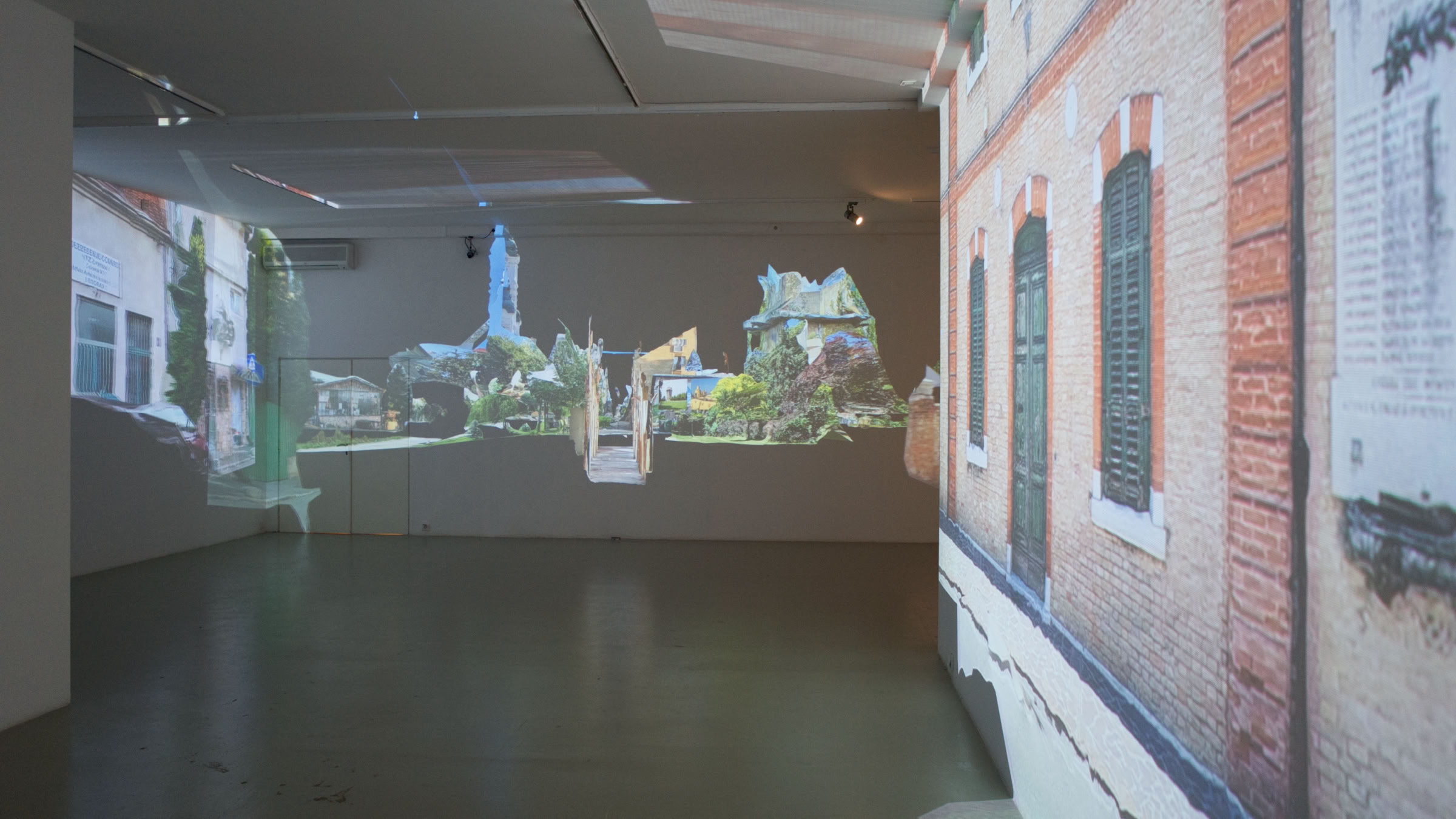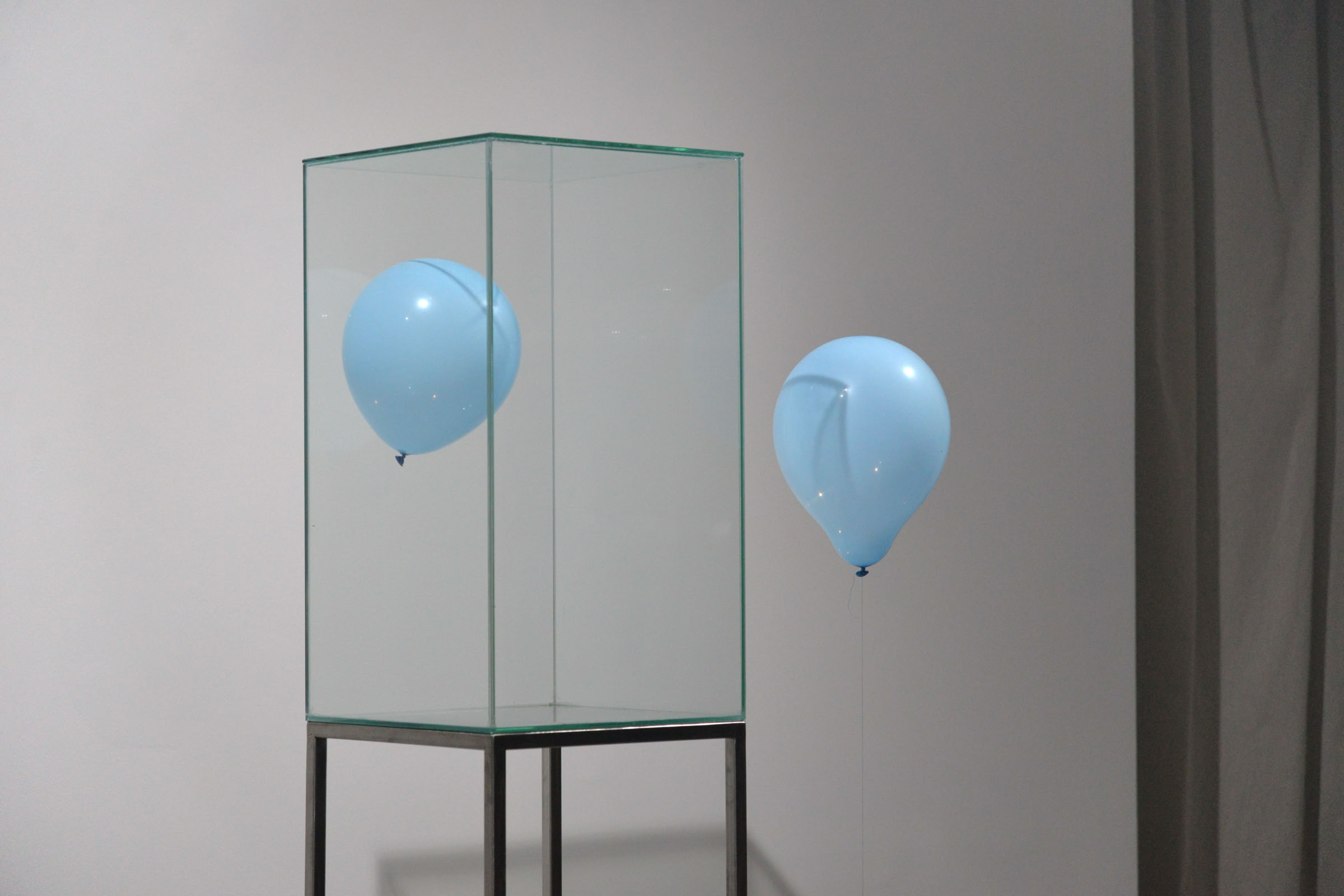Augmented Reality
by Una Popovic
Nemanja Ladjic, in his works, either individual video installations or broader formats at the level of immerse exhibition situations, explores the influence of modern means of communication on our physiological perceptual processes and the psychological experiences of engagement. The exhibition at the Salon of the Museum of Contemporary Art entitled "Safe Distance" is offered to us as a situated, materialized analysis of the representative role of virtual images, i.e., the character of virtual reality. The exhibition is presented as a single narrative composed of three parts, physically separate units that continue upon one another. Though technically and perceptually different, these spatial units are connected linearly, examining perception and perceptibility through the level of imagination, this place formed in cyberspace, what surrounds us virtually and what is realistically imposed on us in the environment. As the central part of the exhibition, the six-channel video installation simulates a street consisting of a collection of moments, places and atmospheres, like a personal travelogue in which all elements are arranged around the point where the real crosses with the experienced. Together with two sculptural installations – as the beginning and the end of the "narrative" – the work constitutes a symbolic study of the evolution of the manifestation of virtual spaces, considering at the same time the different forms of materiality against immaterial space, thus also examining the broader meaning and experience of images and scenes in today's world of digital communication.
The title "Safe Distance" refers to the space in between, a symbolic intermediate space obtained in the distance/difference existing between the actions of the body and the senses in an actual situation and during their complete immersion in the created world of virtual reality. With this exhibition, Ladjic decides to present a phenomenological overview of the different levels of the recipient's perception related to the known/existing and the created. It causes an interesting complication compared to his earlier works and visual research, so metaphorically this can also be an exhibition about the perception of exhibitions or works of art in different media. If the basis of reflection here is perception, then considering an exhibition where material objects are displayed differs from the experience of the recipient of digital art. With the digital image, the work of art has become a process rather than an object, which is why the recipient's perception could be regarded as a particular artistic process. The relationship between reality and the digital world (which can act immersively at the level of image and content, be it advertising, marketing, communication or entertainment) has become more complex and, as such, has become the new normal. It also changed how people act within the new visual and communication agenda. We are familiar with the logic of the action of physical things around us, including those that originate in the domain of "representation," "imitation," "reproduction." However, new cyberspaces offer a new logic of events, fueled by the idea of reviving realism to the extent that it produces immersion, a kind of deep illusion. The material objects and the view of the virtual, their individual and mutual consideration that Ladjic presents in this exhibition, do not speak so much about themselves but about us within the position of the observer, our approach and behavior under the given interface.

In some of his earlier works, Ladjic visually marked the issue of understanding time and space in relation to what is seen. We could analyze the presented examples in two ways, at the level of a document of reality and/or as created images, forms of art. Those were primarily examples from the outside world, exteriors, urban environments, landscapes, as in the works Papierschnitzel (2013/2016), Pop Up (2017), Spieluhr (2017), Delights (2020), etc. Consideration of the frontal point (the seen and recorded landscape) is made possible through the prism of the display that is initially formed within the relations of differences: analog–digital, manual–technological, optical–sensory. Ladjic conveys to us mostly linear, panoramic records, which he further produces into created scenes through digital processing. Although he shows a digital version of the panorama in motion, by using clear manipulation within the scene, the author also hints at the intention to perceive them as long static images of landscapes, where, by moving, we contribute to the sense of motion within the image. In most cases, the scene from reality that the artist uses is photographed and then "brought to life by movement" using computer graphic processing as part of the remediation, possibly through emphasized sequences of the passage of time, days and nights. Ladjic here suggests a reexamination of the very essence of art, raising in his works the issue of the position of space and time – in what way the space and the current age of reality, as well as their established boundaries and limits, become factually flexible and changeable in art.
Thanks to technology, art can be portrayed as an augmented field of reality. Ambient installations, projections in the space, immersive image formats expand our experience of reality. This possibility shows that art can be established as reality in itself if it is shown through the prism of illusion, i.e., as illusory in its foundations. However, the motor behind this ability of art to overcome the space and time of reality is the idea that art originates from fact and is based on it, i.e., it intervenes in reality. In this sense, a double twist occurs – through the prism of art, the reality is either revealed as insufficient, deficient and subject to change, or we conservatively retain it as a criterion and model based on which we can further evaluate art as different, whereby, accordingly, art can exhibit the same insufficiency we initially discover in reality. All traditional definitions of art as a picture, appearance, imitation, illusion or product of fantasy rely on this idea. The work of art, therefore, participates in the space-time continuum of physical reality, but its spatiality and time have a highly specific relationship with that reality. So, regardless of whether the reality is material, virtual or artistic, the question arises: how do these continuums interact with each other? With a view to all of the above, Ladjic deliberately does not go towards the strategy of showing or creating virtual reality (VR) but defines artistic images strictly at the level of augmented reality (AR).

The exhibition "Safe Distance" concludes this field of consideration on various levels. Although it is offered as a single entity, Ladjic arranges examples of reality, artistic space and time in almost three places within the exhibition. The work "The Same Thing" initially introduces us to the story; the balloon in the glass "has" its own logic of space and time, while the balloon on the outside is defined by the parameters of the external world. The video installation "Stroll" in the central room consists of a moving image staged through six projections. The projected material mainly comprises photographs of various city scenes. We recognize that the nature of the image is documentary, although it is deliberately presented as "damaged," full of gaps, breaks, imperfections, which was achieved by a transfer through 3D modeling computer software. Besides emphasizing the possible effect of experiencing scenes from reality as imperfect and disturbing, this is also a deliberate simulation of the passage of time. As we stand in the room, the image moves forward in one direction, and we become aware that it is all a record of the past. From our perspective, the flow of the image is followed as an allusion to the continuum of periods but also memory – in one instance, something is present; in another, it is long gone and possibly even remembered. Also, when we look at the created video as a kind of narrative about a possible future (symbolic and physical collapse of the environment), we are aware that everything that was projected and recorded at some past moment was done for us here, in the present. And the space of today is always enigmatic: it actually functions between the real and the virtual, like now, in the exhibition space of the gallery, where Ladjic responds to the digital image with a materialized example of a bunker in actual dimensions, which, as such, should stage exactly the limited, suppressed, physically and psychologically box-like worlds of both.
Translated by Maja Vojvodić Jovanović